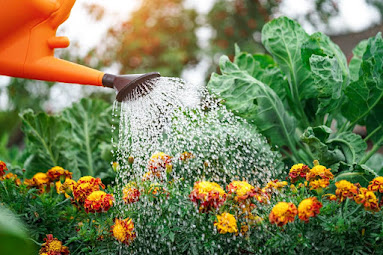Nurturing Blooms: Comprehensive Watering Techniques for Your Flower Garden
Introduction:
Establishing a lush and vibrant flower garden requires more than just selecting the right plants; it involves mastering the art of watering. Proper watering techniques are essential for ensuring the health and longevity of your flowers. In this comprehensive guide, we'll explore various watering methods, timing considerations, and essential tips to help you cultivate a flourishing flower garden.<script async src="https://pagead2.googlesyndication.com/pagead/js/adsbygoogle.js?client=ca-pub-2985789920568613"
crossorigin="anonymous"></script>
Watering your flower garden in the morning is a key strategy. During this time, temperatures are cooler, and the sunlight is less intense, allowing the soil to absorb moisture without excessive evaporation. Morning watering also helps prevent fungal diseases by allowing foliage to dry throughout the day.
<script async src="https://pagead2.googlesyndication.com/pagead/js/adsbygoogle.js?client=ca-pub-2985789920568613"
crossorigin="anonymous"></script>
Root-Specific Watering:
Direct water to the base of plants, focusing on the root zone rather than watering from overhead. This targeted approach ensures that the roots receive adequate moisture while minimizing water waste and reducing the risk of fungal issues on leaves.Deep Watering:
Encourage deep root growth by providing a thorough watering rather than frequent shallow watering. Deep watering promotes stronger, drought-resistant plants by encouraging roots to reach deeper into the soil for moisture.Mulching Magic:
Mulching around flower beds is a water-saving technique that helps retain soil moisture, suppress weeds, and regulate soil temperature. Organic mulches like bark or compost conserve water and enrich the soil as they decompose.<script async src="https://pagead2.googlesyndication.com/pagead/js/adsbygoogle.js?client=ca-pub-2985789920568613"
crossorigin="anonymous"></script>
Drip Irrigation:
Consider installing a drip irrigation system for your flower garden. This method delivers water directly to the root zone through a network of hoses and emitters. Drip irrigation is efficient, minimizes water wastage, and allows for precise control over watering schedules.
Soil Moisture Monitoring:
Get to know your soil and its moisture needs. Invest in a moisture meter to assess soil moisture levels regularly. Adjust your watering schedule based on the specific requirements of your flowers and the moisture-retaining capacity of your soil.<script async src="https://pagead2.googlesyndication.com/pagead/js/adsbygoogle.js?client=ca-pub-2985789920568613"
crossorigin="anonymous"></script>
Container Considerations:
<script async src="https://pagead2.googlesyndication.com/pagead/js/adsbygoogle.js?client=ca-pub-2985789920568613"
crossorigin="anonymous"></script>
Rainwater Harvesting:
Consider utilizing rain barrels to collect and store rainwater for your flower garden. Rainwater is naturally free of chlorine and other additives found in tap water, making it an eco-friendly and cost-effective watering option.Avoid Overhead Sprinkling:
While convenient, overhead sprinklers can wet the foliage, potentially leading to fungal diseases. If using sprinklers, water in the morning to allow leaves to dry before evening, or consider switching to drip irrigation for more targeted watering.Adapt to Seasonal Changes:
Adjust your watering routine based on seasonal variations. Flowers generally require more water during the hot summer months and less during the cooler fall and winter seasons. Be attentive to weather conditions and adapt your watering schedule accordingly.<script async src="https://pagead2.googlesyndication.com/pagead/js/adsbygoogle.js?client=ca-pub-2985789920568613"
crossorigin="anonymous"></script>
Conclusion:
Achieving a thriving flower garden involves mastering the subtle art of watering. By incorporating morning moisture, root-specific watering, deep watering, mulching, drip irrigation, soil moisture monitoring, container considerations, rainwater harvesting, and adapting to seasonal changes, you can ensure your garden blooms with vitality and color. Remember, a well-hydrated garden not only enhances the beauty of your outdoor space but also promotes the overall well-being of your cherished floral companions.FAQs:
1. How often should I water my flower garden?
- The frequency of watering depends on factors such as weather conditions, soil type, and plant species. Generally, it's best to water deeply but infrequently, allowing the soil to dry out slightly between watering sessions.
2. What is the best time of day to water flowers?
- Watering in the early morning or late afternoon is ideal as it minimizes water loss due to evaporation and allows plants to absorb moisture more effectively.
3. How can I tell if my flowers are getting enough water?
- Check the soil moisture level regularly by inserting your finger into the soil. If it feels dry several inches below the surface, it's time to water. Additionally, observe your plants for signs of stress, such as wilting or yellowing leaves.
4. Should I water my flower garden during rainy periods?
- It's generally unnecessary to water your garden during rainy periods, as natural rainfall provides sufficient moisture. However, if your garden is situated under cover or receives limited rainfall, supplemental watering may still be required.
5. What are some water-saving techniques for flower gardens?
- To conserve water in your flower garden, consider using drip irrigation systems, mulching to reduce evaporation, collecting rainwater in barrels, and selecting drought-tolerant plant varieties.




.jpg)
No comments:
Post a Comment